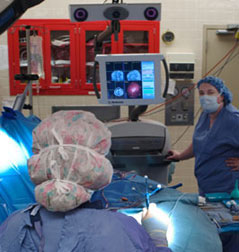
Navigation systems
Stealth Systems

United Hospital has three Stealth System units. These advanced computer-assisted, image-guided navigational systems for neurosurgery of the head and spine give surgeons the ability to plan, navigate and precisely position surgical instruments and devices during head, brain, spine fusion, sinus surgery and general orthopedic procedures.
The Stealth System incorporates each patient's MRI or CT scans into the computer to create a 3-D model. Based on this, the Stealth System uses a navigational system similar to a global positioning system to guide the surgeon's movements and instruments during the operation.
Once a surgeon's instrument touches the patient, an optical scanner mounted above the operating table senses the instrument and establishes a 3-D location. Instantly, this location is indicated on a monitor within the physician's sight where lines are displayed over the patient's MRI scans.
The benefits of a Stealth System are surgical localization accuracy by the creation of a virtual plan of the surgical procedures, visualization of the anatomy in 3-D and reduced operating room cost and length of stay for the patient. This technology is also modular and can be moved from room to room.
C-arm CT with SIREMOBILE Iso-C3D

The state-of-the-art C-arm CT can be used in spine and orthopedic surgery, as well as urology and vascular surgeries. The C-arm CT with SIREMOBILE Iso-C3D offers 3-dimensional imaging that improves accuracy, safety and efficacy, while reducing the need for revisions, cost and operating room time. In addition to the 3-D imaging capability, the C-arm CT with SIREMOBIL Iso-C3D includes such unique features as:
- Isocentricity, a design capability that keeps the X-ray beam centered on the region of interest throughout the 190° scanning range of the C-arm. This means repositioning of the patient is eliminated, resulting in savings in time and radiation dose,
- Software that allows the system to be used with our Stealth Systems for use in spinal fusion, as well as general orthopedic procedures, and
- Axial views of the spine.
Neurophysiological monitoring
Monitoring of essential functions during operative procedures for ENT, neurosurgical, orthopedic and vascular procedures is available. Onsite physician interpretation is standard. The testing modalities include:
- EEG during carotid endarterectomy or aortic aneurysm repair
- Evoked potentials: somatosensory, brainstem auditory
- Motor evoked potentials
- Electromyography: passive and triggered techniques from peripheral and cranial nerves
Neurodiagnostic laboratory
State-of-the-art digital EEG recording is available for outpatient and hospital inpatient evaluation of brain function. After hours on-call studies can be performed for urgent needs as determined by a neurologist. Staff neurologists interpret the EEG recordings within 24 hours.
EMG and nerve conduction studies are available in the laboratory and performed by qualified technicians and on-staff neurologists or PM&R physicians.